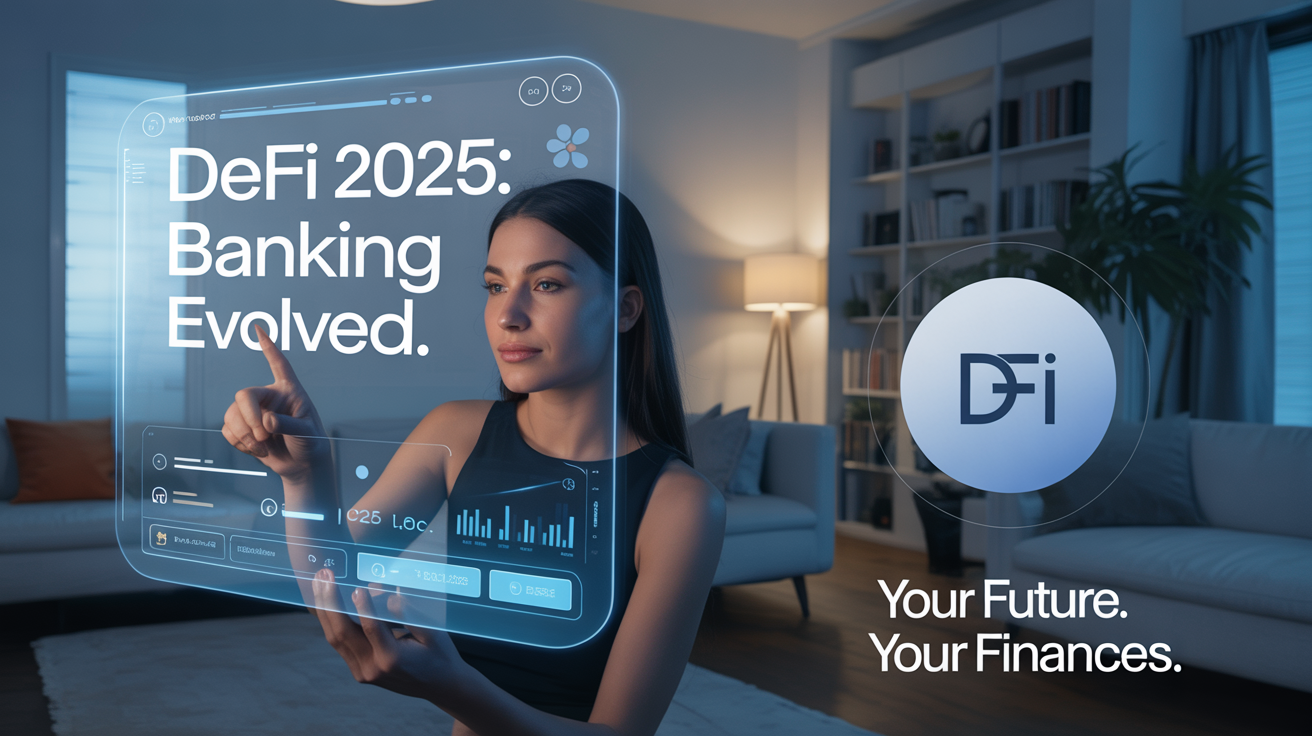Imagine a world where you can borrow, lend, or trade assets instantly, without a bank’s approval or hefty fees. This is the promise of Decentralized Finance (DeFi), a blockchain-based revolution reshaping how we interact with money. In 2025, crypto and DeFi are no longer niche concepts but transformative forces challenging traditional banking. With global DeFi markets projected to grow at a 48.9% CAGR to $351.75 billion by 2031, the question isn’t whether DeFi will impact banking—it’s whether it could replace it. This article dives into how DeFi works, its potential to redefine banking, real-world examples, and what’s new in 2025. Whether you’re a crypto novice or a seasoned investor, discover how Decentralized Finance can empower your financial future.
Understanding Decentralized Finance (DeFi)
Decentralized Finance uses blockchain technology and smart contracts to offer financial services like lending, borrowing, trading, and insurance without intermediaries like banks. Built primarily on Ethereum, DeFi platforms operate on transparent, immutable ledgers, ensuring trust and accessibility.
Why DeFi Matters
- No Intermediaries: Smart contracts automate transactions, cutting out middlemen.
- Global Access: Anyone with an internet connection can participate, regardless of location.
- Transparency: Transactions are recorded on public blockchains, ensuring accountability.
- Cost Efficiency: Lower fees compared to traditional banking systems.
External Link: CoinMarketCap on DeFi basics.
How DeFi Is Challenging Traditional Banking
1. Decentralized Lending and Borrowing
Unlike banks requiring credit checks and lengthy approvals, DeFi platforms like Aave and Compound offer instant loans using cryptocurrency as collateral. Lenders earn competitive interest rates by providing liquidity.
Case Study: Emma, a small business owner in Nigeria, needed a $5,000 loan but faced high bank fees. Using Aave, she deposited Ethereum as collateral and received a stablecoin loan in minutes, saving 20% in fees compared to traditional banks.
Suggested Visual: A diagram comparing traditional bank loans vs. DeFi lending processes.
2. Decentralized Exchanges (DEXs)
DEXs like Uniswap and Curve Finance allow users to trade cryptocurrencies directly, bypassing centralized exchanges. Automated Market Makers (AMMs) ensure liquidity, making trading faster and cheaper.
Example: Mark, a U.S. investor, swapped $1,000 of ETH for DAI on Uniswap. The transaction took seconds and cost $2 in gas fees, compared to $15 on a centralized exchange.
Internal Link: Explore our guide to DEXs.
3. Yield Farming and Staking
DeFi protocols like Yearn Finance optimize returns through yield farming, automatically moving assets to high-yield pools. Staking, used by platforms like Lido, lets users earn rewards by securing blockchain networks.
What’s New in 2025: Liquid staking derivatives (LSDs) like Lido’s stETH allow users to stake assets while retaining liquidity, driving DeFi adoption.
4. Tokenization of Real-World Assets (RWAs)
DeFi is tokenizing assets like real estate and bonds, making them accessible to retail investors. In 2024, RWA market value surpassed $12 billion, with projections of $16 trillion by 2030.
Example: Sarah invested $500 in tokenized real estate via Archblock, owning a fraction of a property that was previously unaffordable.
External Link: Binance Research on RWA tokenization.
5. Financial Inclusion
DeFi provides services to the unbanked, with 1.4 billion people globally lacking access to traditional banking. Platforms like Stellar enable low-cost remittances, vital for developing economies.
Suggested Visual: A global map highlighting DeFi adoption in underbanked regions.
Pros and Cons of DeFi vs. Traditional Banking
| Aspect | DeFi | Traditional Banking |
|---|---|---|
| Accessibility | Open to anyone with internet | Requires IDs, credit checks |
| Speed | Instant transactions | Days for loans, transfers |
| Fees | Low (gas fees) | High (processing fees) |
| Security | Blockchain-based, hack risks | Regulated, insured deposits |
| Regulation | Limited, evolving | Strict, established |
What’s New in DeFi for 2025
- Regulatory Clarity: The U.S. repealed the IRS’s DeFi broker rule, boosting investor confidence.
- Cross-Chain Interoperability: Bridges like Polkadot enable seamless asset transfers across blockchains, enhancing DeFi usability.
- AI Integration: AI-driven platforms optimize yield farming and detect threats, with protocols like Bittensor leading the way.
- DeFi 2.0: Improved scalability and user-friendly interfaces make DeFi accessible to non-crypto natives.
- Institutional Adoption: Banks like Sygnum are integrating DeFi for riskier onchain products.
External Link: Forbes on 2025 crypto trends.
How to Get Started with DeFi
- Set Up a Wallet: Use MetaMask or Trust Wallet to store crypto.
- Buy Cryptocurrency: Purchase ETH or stablecoins on exchanges like Coinbase.
- Choose a Platform: Start with Uniswap for trading or Aave for lending.
- Research Risks: Understand smart contract vulnerabilities and gas fees.
Tip: Begin with small investments to test platforms, and use resources like DeFi Pulse for market insights.
FAQ Section: Your Questions About DeFi Answered
1. What Is Decentralized Finance (DeFi) and How Does It Work?
Decentralized Finance (DeFi) is a blockchain-based system offering financial services without intermediaries. Smart contracts on platforms like Ethereum automate lending, borrowing, and trading. Users deposit crypto into protocols like Aave, earning interest or receiving loans instantly. Transactions are transparent, recorded on public ledgers, and accessible globally. In 2025, DeFi’s market is valued at $80.048 billion, with growth driven by interoperability and user-friendly interfaces.
Actionable Tip: Start with a beginner-friendly platform like Uniswap. Connect a wallet, swap small amounts of ETH, and monitor gas fees to avoid high costs.
2. Can DeFi Replace Traditional Banking?
DeFi offers faster, cheaper, and more accessible services, but it won’t fully replace banks soon. Banks provide regulated security and trust, while DeFi faces scalability and regulatory hurdles. Hybrid models, combining DeFi’s efficiency with banking’s stability, are emerging in 2025.
Actionable Tip: Use DeFi for low-cost remittances or yield farming, but keep savings in insured bank accounts for security.
3. How Safe Is DeFi for Financial Transactions?
DeFi uses blockchain for transparency, but risks like smart contract hacks persist. In 2025, protocols like CertiK enhance security with audits. Always use reputable platforms and enable multi-signature wallets.
Actionable Tip: Research platforms on DeFi Llama and store keys in hardware wallets like Ledger for added safety.
4. How Can I Start Investing in DeFi?
Begin by setting up a wallet like MetaMask, buying ETH, and exploring platforms like Compound or Yearn Finance. Start small to learn, and diversify across protocols to reduce risk. In 2025, liquid staking and RWA tokenization offer new opportunities.
Actionable Tip: Allocate 5-10% of your portfolio to DeFi, focusing on stablecoin pools to minimize volatility.
5. What Are the Risks of Using DeFi Platforms?
Risks include smart contract vulnerabilities, regulatory uncertainty, and market volatility. Hacks cost DeFi users $3.7 billion from 2020-2024. In 2025, AI-driven security and insurance protocols like Nexus Mutual mitigate risks.
Actionable Tip: Use platforms with audited contracts and consider DeFi insurance for protection.
6. How Does DeFi Promote Financial Inclusion?
DeFi provides banking services to the unbanked, with 1.4 billion people lacking access to traditional finance. Platforms like Stellar offer low-cost transfers, vital for developing regions. In 2025, mobile-first DeFi apps enhance accessibility.
Actionable Tip: Explore DeFi remittance platforms like Ripple for cross-border payments to save on fees.
Conclusion: The Future of Finance Is Here
In 2025, Decentralized Finance (DeFi) is reshaping banking with its promise of transparency, accessibility, and efficiency. From instant loans to tokenized assets, DeFi empowers users to take control of their finances. While challenges like regulation and security remain, hybrid models blending DeFi and traditional banking signal a transformative future. Ready to explore crypto and DeFi? Start small, research thoroughly, and join the financial revolution. Share your thoughts in the comments or sign up for our newsletter for the latest DeFi updates!


1 thought on “DeFi in 2025: The Future of Banking Unveiled”